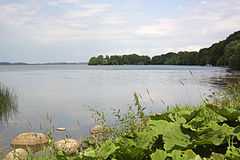Lake Esrum
| Esrum Sø | |
|---|---|
 Lake Esrum | |
| Location | Zealand |
| Coordinates | 56°00′14″N 12°22′50″E / 56.00389°N 12.38056°ECoordinates: 56°00′14″N 12°22′50″E / 56.00389°N 12.38056°E |
| Type | kettle hole (probably) |
| Primary inflows | Fønstrup Bæk,[1] several smaller streams, groundwater |
| Primary outflows | Esrum Å |
| Catchment area | 62 km² |
| Max. length | 8.4 km |
| Surface area | 17.3 km² |
| Average depth | 13.5 m |
| Max. depth | 22.3 m |
| Water volume | 233 mill. m³ |
| Residence time | 12.7 years |
| Surface elevation |
Below 9.38 m in the summer. Below 9.48 m in the winter. |
| Settlements | Fredensborg, Hillerød |
Lake Esrum (Danish: Esrum Sø) is the largest lake in Denmark by water volume and the second-largest lake by surface area, after lake Arresø. It is situated in the region of Hovedstaden, on the island of Zealand.
The surface area of the lake is 17 km² and the maximum depth is 22 m. The length from north to south is 8.4 km. On the western shore is the Gribskov forest and on the eastern shores is the Fredensborg Castle.
History
Commercial fishing
Like many of the surrounding forests, Lake Esrum was originally a royal domain. It was first administrated by Tentekammeret and later by Frederiksborg Amtsstue on behalf of the Danish government. Fishing in the lake was entrusted with a fishing master (Danish: fiskemester) who resided at Fiskergården, located next to Slotsmøllen at Slotssøen in Hillerød. From 1864, fishing was carried out by private citizens and from 1907, fishing rights were sold at auction. Commercial fishing continued until 1989.
Esrum canal

From the beginning of the 19th century, Lake Esrum played a role in the transport of firewood from Grib Forest to Copenhagen. From 1802 to 1805, a canal was constructed between the north end of the lake and Dronningmølle. Here firewood was loaded onto large cargo ships and sailed to Copenhagen. The canal was 9 km long, 9 m wide and 1.5 m deep. The work was led by Adolph von der Recke and carried out by local peasants, soldiers and forced labour workers. A towpath ran on the banks of the canal and on the western shores of lake Esrum. The timber had to pass a 4-metre crater-like ramp called Væltningen, which connected the upper section of the canal to its lower part. The upper part of the canal passed two ponds. One of them, Storedam (Great Pond), was the site of a watermill which was first used as backup for the gunpowder mill in Frederiksværk during the English Wars and later for the manufacturing of textiles for the army. Transportation of firewood on the canal continued until 1874 and it was later used for leisure trips. It has now dried out and been covered by forest, but Væltningen and other elements are still visible in the landscape.[2]
.jpg)
Sørup's laundries
From the middle of the 19th century, the small village of Sørup on the southeastern shores of the lake was home to numerous laundries. The laundry was picked up at institutions and wealthy households in both Copenhagen, Hillerød and Elsinore. When the industry peaked, Sørup was home to 20 laundries with some one hundred employees.[3]
Hydrology
The water quality of lake Esrum is considered good.
Since 2002, there have been a few incidences of trematoda plaguing swimmers in the summertime every year. The trematodes are a natural part of lake Esrums' aquatic life.
Fauna
Fish
Lake Esrum have a large population of European perch and Northern pike. Other species includes European eel, ruffe, bream, roach, tench and bleak. A smaller population of brown trout is living here, having adapted to the freshwater.
The professional fishing for eel, was previously substantial, but in 1997 the annual catch had fallen to 388 kg from a mere 14 tons. Nowadays, the lake is exclusively fished by anglers.
Birds
The birdlife at the lake is varied. The common goldeneye was formerly a rare breeding bird in Denmark, but after a determined effort involving setting up artificial nests, the species is almost a signature of lake Esrum. Other common birds here includes Eurasian coot, mallard, tufted duck, great crested grebe and mute swan. The reed beds along the lake brinks, hold many swan nests and in the southern end, a colony of the great cormorant have found a home, with several hundreds of nests.
Protections
Lake Esrum is part of a larger 7,400 ha Natura 2000 area, comprising Gribskov and a few smaller woodlands nearby. [4]
References
- ↑ Stenholt Mølle resevatet Danish Nature Agency, last paragraph
- ↑ "Pramfarten på Esrum Å" (in Danish). Folk og minder i Nordsjælland. Retrieved 2014-12-04.
- ↑ "Overdådigt værk fortæller lokalhistorien om Esrum Sø" (in Danish). Politiken. Retrieved 2014-12-04.
- ↑ 133 Gribskov, Esrum Sø, Esrum Å and Snævret Skov Danish Nature agency (Danish)
Sources
| Wikimedia Commons has media related to Esrum Sø. |
- Esrum Sø Danish Nature Agency (Danish)